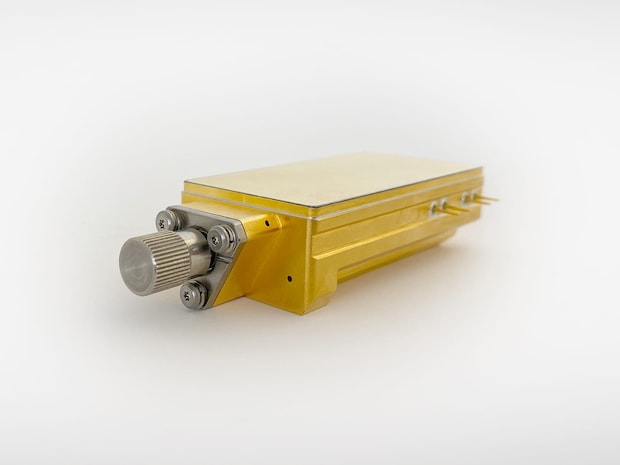RecommendMail Facebook LinkedIn
- Mobility
European-Russian Mars mission uses Jenoptik lasers to help seek signs of life on Mars
The Jetson’s, Star Trek, Star Wars, The Hitchhiker's Guide to the Galaxy. These are just a few space exploration journeys that have been captivating imaginations worldwide for decades. Still to this day, space with its unexplored secrets has a magical fascination for mankind. Discovering and decrypting it is an exciting yet challenging task and a journey at the same time. In 2022, the European and Russian space agencies ESA and Roskosmos will set off on their next voyage into space together to continue the "ExoMars" mission that started in 2016. Their aim is to explore our neighboring planet Mars and discover signs of organic life with the help of diode laser modules designed and built by Jenoptik.
, Ekkehard WernerExtraterrestrial life in endless space: Are there traces of life on Mars?
Far-off galaxies and unexplored regions of interstellar space have sparked the imagination of the the world and has inspired pop culture for decades.
But is there actually life in space? And if so, in what form? Experts have been grappling with this question for many decades. The dream of exploring the Red Planet is just as old, with the first Mars mission beginning in the 1960s.

The Mars mission ExoMars means that an answer to the question of life on Mars is now within reach. The name of the mission already says it all: ExoMars is analogous to exobiology, i.e. science for the research of alien life, its origins and existence. This is precisely the objective of the two-stage ExoMars mission of the European Space Agency (ESA) and the Russian space agency Roskosmos: Its aim is to find signs and traces of organic life on Mars. T
The ExoMars expedition is supported by the American Space Agency NASA (National Aeronautics and Space Administration), which is contributing to the success of the mission with scientific and technical expertise and technology.
Two missions with one objective: To find signs of life on Mars
The first part of the ExoMars mission began in 2016 when the Trace Gas Orbiter (TGO) made its way to Mars with the Schiaparelli test module, which was designed for atmospheric entry and landing. Originally planned for 2018 and later for 2020, step two of the expedition will now commence in 2022 with the analysis of sample material on Mars.
Unfortunately, due to technical problems the Schiaparelli test landing module was unable to land on Mars as planned in 2016. Nevertheless, researchers drew valuable conclusions and insights from the failed landing attempt on Mars, which were then incorporated into the upcoming second stage of the mission. Since then, the TGO, which weighs just under four metric tons, has been orbiting Mars examining its atmosphere for gases such as methane and analyzing hydrogen on and under the surface of Mars. Methane gas is often an indication of biological life, which is why researchers hope to see signs of life on Mars.
In autumn 2022, the second part of the ExoMars mission will follow and the European Mars rover "Rosalind Franklin" with the Russian landing platform "Kazachok" will enter orbit. The research goal of the expedition is to search for signs of life on Mars by detecting organic traces. After a nine month journey through space, the Mars rover is expected to land on the Red Planet in spring of 2023 and the TGO will then serve as a relay station for the rover to communicate with Earth.
Once on Mars, the rover will leave the platform and explore the planet to fulfill its mission to find signs of life. For its part, the platform will also conduct surveys of the surface environment at the landing site in order to analyze, for example, the climate and atmosphere of Mars.
On board of the rover there will be a range of scientific and highly sensitive measuring instruments and systems from various international institutions that will withstand the specific conditions of the Mars atmosphere and will take an important step forward in analyzing and unlocking information on the exobiology and the geochemical constellation of the Red Planet. To this end, a drill will be used to take samples from a depth of up to two meters under the surface of Mars and analyze them for signs of past or present life there. Afterwards, the samples will be transferred to the rover's laboratory, crushed and then analyzed using the instruments on board.
Martians that resemble those depicted in some science fiction films are certainly not to be expected on Mars, but researchers hope to find traces of microorganisms that can survive in the Martian atmosphere or may have existed there in the past.
Looking for signs of life: Mars exploration with "MOMA"

One of these highly sensitive measuring instruments is "MOMA". MOMA (Mars Organic Molecule Analyzer) will seek to answer the longstanding question of whether there are signs of life on Mars. It will be launched into space as part of the Mars rover under the responsibility of the Max Planck Institute for Solar System Research. Analytical methods of soil and rock testing are intended to detect organic traces and reveal the secrets of the Red Planet.
Part of the MOMA scientific measuring instrument is a so-called laser desorption mass spectrometer with a diode-pumped laser. By irradiating crushed samples of sediment rock with high-energy laser pulses, ions are generated, whose composition will be examined using a mass spectrometer. The findings are intended to provide information on whether and how life on Mars emerged and developed.
How lasers will help identify signs of life on Mars
The photonic heart of this laser is a Jenoptik diode laser module, which serves as a pump source. Small, compact and powerful diode laser modules have been part of Jenoptik's product portfolio for many years. They are suitable for pumping both solid-state and fiber lasers and direct material processing. Long service life, maximum reliability, compact design and efficiency are their characteristic features.
The diode laser module, which will set out for the Red Planet in 2022 as part of the ExoMars mission, has been specially developed and manufactured in Jena for the space expedition. The module is designed to withstand the atmospheric conditions of Mars and the challenges of the expedition, such as pressure, climatic fluctuations or vibrations during take-off and landing maneuvers.
In addition to this robustness, it is also characterized by its long service life, as explorations on Mars are scheduled to take at least seven months and the Mars rover is intended to cover about four kilometers of the Mars surface.
To make sure that the diode laser module is optimally equipped for a journey into space, Jenoptik engineers have conducted numerous and extensive tests to ensure the module's functionality under diverse conditions. Since every gram counts when flying into space, attention was also paid to a small and light design.
Whether you are a Trekkie, into sci-fi, a space aficionado or a laser engineer, the world is looking forward to 2022 and seeing what new insights into the building blocks of life the Mars rover will reveal in the memory of Rosalind Franklin.
If you are also looking for customer-specific laser solutions for your challenging projects, contact us today to learn how our many years of experience and expertise can launch your ideas to new heights.
*Courtesy of Max Planck Institute for Solar System Research.
Good to know: Mars at a glance

- Why is Mars often referred to as the Red Planet?
The presence of iron oxide makes Mars appear red. - How big is Mars?
Mars has a diameter of 6,794 kilometers. - What is the temperature on Mars?
On average the temperature is -55°C. The differences range from +27°C in summer to -133°C at the winter pole. - How far is our neighboring planet from Earth?
The distance is between 56 million and more than 400 million kilometers. This figure is based on different planet speeds on their orbits around the sun. - What does the surface of Mars look like?
The surface of Mars is characterized by volcanic eruptions of bygone times and the impacts of meteorites, mountains, gorges and icy pole caps. An extinguished volcano of gigantic proportions is particularly striking: The diameter of the crater is 80 kilometers and the Olympus Mons is 26 kilometers tall. This makes it the largest volcano in the solar system. - Why is Mars so exciting for research?
Water and life are closely related on Earth. Water is the origin of life and there can be no living beings without water. Today, Mars is dry, but if there was once water on Mars, it is reasonable to assume that life existed there as well. - Why is the rover called Rosalind Franklin?
The Mars rover is named after Rosalind Franklin, an X-ray expert and chemist whose pioneering work led to the discovery of the DNA double helix, the blueprint of life. After all, the rover will be looking for signs of life on Mars.
Product recommendation
About Ekkehard Werner
Dr. Ekkehard Werner studied physics with subsequent promotion and has been working for Jenoptik since 2004 in various management positions in the field of Research & Development. With his team, he is responsible for design and development of reliable and efficient laser beam sources and for effective mounting and connection technologies. A particular focus of his work is the development and advancement of powerful diode laser modules, which are used for applications such as solid-state laser pumps or for direct material processing. For "ExoMars" he was responsible for the diode laser modules provided by Jenoptik for the Mars mission.







